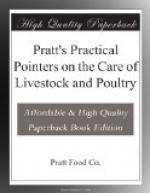Grading consists in mating thoroughbred sires with common females and with the female progeny for a number of generations. Where the work is wisely done by the use of good sires, accompanied by the rejection of all inferior animals for future breeding, the progeny of beef sires may be brought up to the level of the pure breed for beef making from which the sires have been selected in four generations. To bring milking qualities up to the level may call for one or two more generations of such breeding. Not only do these grade animals answer almost equally well, with pure breeds, but they may be bought for much less.
If cows are to produce a maximum return in milk, they must be kept in comfort. In winter they are usually tied in the stall. The light should be ample and the ventilation thorough. Lack of proper ventilation causes the spread of tuberculosis in cattle.
Cows must be allowed exercise, even in winter.
They should be allowed to go out daily for an hour or more into a sheltered yard, save on days when the weather is extreme; or, better still, be given the liberty of a closed and well-ventilated shed during a portion of the day. It should be supplied with a fodder rack.
In summer, cows in milk must be protected from storms, from excessive sunshine, and from flies, as far as this may be practicable. Pratts Fly Chaser is unequalled as a fly repellant. It is perfectly safe to use, does not injure or gum the hair, and is economical. A light spray is both lasting and effective.
Cows in milk should be driven gently. The pasture should not be too distant from the stable, and driving during the heat of the day should be avoided.
The quality of milk is easily injured by coming in direct contact with foreign substances or by imbibing odors. The milk must be drawn from clean udders, with clean hands, into clean pails, and amid clean surroundings. The stables must have attention. The udder and teats should be wiped off by using a damp cloth. Milking should be done with dry hands into metal pails, kept clean by scalding. Milking before feeding prevents dust particles from getting into the milk. Noxious odors are kept down by the prompt removal of droppings and by strewing sand, plaster, rock phosphate, or dry earth in the manure gutters.
-------------------------------------------------------
---------- Elderton, Pa.
“I have used Pratts
Cow Remedy with best results. I fully believe
it cannot be surpassed
for increasing the flow of milk.”
JAS. YOUNG._ ------------------------------------------------------------
-----
Unless milking is done at stated times, and by the same person, there will be a loss in the production. When milking is delayed, a decreased flow is noticeable the following morning. When a change of milkers is made, some cows resent it by withholding a part of the milk.
It is not easy to dry some dairy cows prior to the birth of the next calf, and yet, as a rule, it ought to be done. When they are to be dried the process should begin by milking them once a day and putting them on dry food. The food may also be reduced somewhat in quantity. Later the milk is taken out at intervals which constantly increase in length until the cow is dry. The udder should be carefully watched during the later stages of the drying process.




